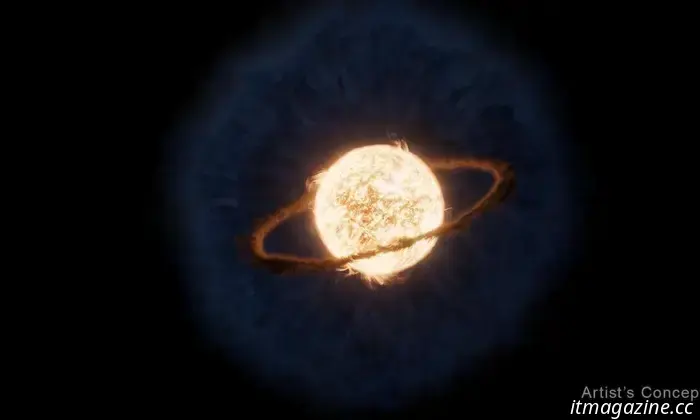
James Webb monitors the events that occur when a planet is engulfed by a star.
NASA's James Webb Space Telescope has made observations of what is believed to be the first ever documented event of a planet being engulfed by its star, revealing a hot accretion disk surrounding the star and an expanding cloud of cooler dust enveloping the area. Webb's findings also showed that the star did not expand to consume the planet; rather, it was the planet's orbit that gradually decayed over time.
Describing the planetary demise, it is a grim scenario: a planet spiraling closer to its host star, becoming increasingly hotter until it crosses the point of no return and is engulfed by the star in a brilliant flash of light. This event, designated ZTF SLRN-2020, has been under investigation by the James Webb Space Telescope to glean more insights about this unusual occurrence.
“Given the uniqueness of this event, we had no clear expectations when we aimed the telescope at it,” noted lead researcher Ryan Lau of NOIRLab, who utilized Webb’s MIRI (Mid-Infrared Instrument) and NIRSpec (Near-Infrared Spectrograph) for observations. “With its high-resolution infrared capabilities, we are gaining important insights into the ultimate fates of planetary systems, potentially including our own.”
Initially, astronomers believed that the planet was annihilated when the star expanded and swallowed it. However, with the newest data, they now postulate that the planet gradually spiraled inward until it was completed engulfed by the star.
“The planet began to graze the star’s atmosphere, which triggered a rapid descent from that point onward,” explained Morgan MacLeod from the Harvard-Smithsonian Center for Astrophysics. “While falling in, the planet started to spread out around the star.”
As the planet descended towards the star, it expelled layers of gas from the star’s outer atmosphere, and this gas gradually cooled and transformed into cold dust now surrounding the star. Within this cold dust, there lies a smaller disk of heated gas closer to the star, which contains carbon monoxide.
“With a groundbreaking telescope like Webb, I was unsure of what to expect in the star’s immediate vicinity,” commented Colette Salyk from Vassar College. “I must say, I was not anticipating to observe features that resemble a planet-forming region, even though actual planet formation is not occurring here in the aftermath of the engulfment.”
Such an event is extremely rare, yet the researchers are hopeful that they will be able to observe more comparable occurrences in the future, using both the Webb and upcoming telescopes like the Vera C. Rubin Observatory and NASA’s Nancy Grace Roman Space Telescope.
“This marks a significant step in studying these phenomena. This is the only event we have witnessed in real time, and it provides the best detection of the aftermath once conditions have stabilized,” stated Lau. “We hope this is merely the beginning of our findings.”
The study has been published in The Astrophysical Journal.
Georgina has been the space writer at Digital Trends for six years, covering topics related to human space exploration and planetary science.
In related news, Webb and Hubble have captured images of the same galaxy, showcasing how each telescope reveals different details of one object. The galaxy NGC 2090 was photographed by Webb using its MIRI and NIRCam instruments. These tools operate in the mid-infrared and near-infrared ranges of the electromagnetic spectrum, causing the galaxy's arms, composed of swirling gas and dust, to appear red. The central part of the galaxy, glowing blue, indicates a cluster of young stars that are hot and bright.
Additionally, a new image from the James Webb Space Telescope displays the striking Sombrero Galaxy, so named for its hat-like appearance. With its broad, flat shape reminiscent of a hat's wide brim, this galaxy, also known as Messier 104, reveals outer rings for the first time. It is located 30 million light-years away in the Virgo constellation, and while previously imaged by the Hubble Space Telescope, the new Webb image shows an outer blue disk and a small, bright core at its center.
Furthermore, a recently released Halloween-themed image utilizes data from both the Hubble and James Webb Space Telescopes, featuring a pair of galaxies — IC 2163 and NGC 2207 — that appear to be engaging in a cosmic dance, creating an eerie facial resemblance. The galaxies are not colliding directly, with one merely passing in front of the other; however, they are close enough to influence each other gravitationally. The spiral arms of the left galaxy have been stretched into a distorted shape due to this close interaction. The bright red areas around the "eyes" are the result of shock waves generated by the collision of material from both galaxies.





Other articles
 Act quickly: The 65-inch LG G4 OLED won't be discounted by $800 for much longer.
The LG 65-inch G4 Series 4K OLED is among our top TV deals this week. You can buy it at Amazon, Best Buy, or LG for just $2,000.
Act quickly: The 65-inch LG G4 OLED won't be discounted by $800 for much longer.
The LG 65-inch G4 Series 4K OLED is among our top TV deals this week. You can buy it at Amazon, Best Buy, or LG for just $2,000.
 The Kia EV9 and EV6 are now completely eligible for the $7,500 tax credit, with the exception of one trim.
Kia's top-selling EV6 and EV9 models are now entirely manufactured in the U.S., allowing them to be eligible for the $7,500 tax credit. However, the GT trims for both models do not qualify.
The Kia EV9 and EV6 are now completely eligible for the $7,500 tax credit, with the exception of one trim.
Kia's top-selling EV6 and EV9 models are now entirely manufactured in the U.S., allowing them to be eligible for the $7,500 tax credit. However, the GT trims for both models do not qualify.
 BenQ RD280UA Monitor Review: The Ideal Monitor Exclusively for Coders
The BenQ RD280UA is an excellent monitor for programmers, offering several features that enhance text readability and minimize eye strain. However, it may not be the ideal choice for other users.
BenQ RD280UA Monitor Review: The Ideal Monitor Exclusively for Coders
The BenQ RD280UA is an excellent monitor for programmers, offering several features that enhance text readability and minimize eye strain. However, it may not be the ideal choice for other users.
 Dreo introduces new smart home gadgets to assist you in overcoming the summer heat.
Dreo unveiled several new smart home gadgets, all aimed at enhancing your comfort this summer.
Dreo introduces new smart home gadgets to assist you in overcoming the summer heat.
Dreo unveiled several new smart home gadgets, all aimed at enhancing your comfort this summer.
 These JBL noise-canceling headphones are currently 20% off, but act fast!
The JBL Live 770NC Wireless Headphones are currently available for $160. You can buy them at Amazon, Best Buy, or Walmart to benefit from this fantastic price reduction.
These JBL noise-canceling headphones are currently 20% off, but act fast!
The JBL Live 770NC Wireless Headphones are currently available for $160. You can buy them at Amazon, Best Buy, or Walmart to benefit from this fantastic price reduction.
 AR driving is finally here – this Android Auto feature may enable navigation on smart glass.
AR driving is finally here - this Android Auto feature could allow for navigation on smart glass.
AR driving is finally here – this Android Auto feature may enable navigation on smart glass.
AR driving is finally here - this Android Auto feature could allow for navigation on smart glass.
James Webb monitors the events that occur when a planet is engulfed by a star.
A planet was consumed by its star, as explored by James Webb.
